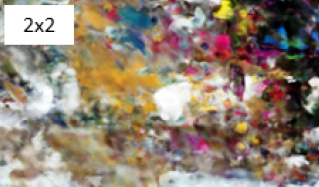
Neural Radiance Fields (NeRF) have attracted particular attention due to their exceptional capability in virtual view generation from a sparse set of input images. However, their scope is constrained by the substantial amount of images required for training. This work introduces a data augmentation methodology to train NeRF using external depth information. The approach entails generating new virtual images at different positions through the utilization of MPEG's reference view synthesizer (RVS) to augment the training image pool for NeRF. Results demonstrate a substantial enhancement in the output quality when employing the generated views in comparison to a scenario where they are omitted.

Image classification is extensively used in various applications such as satellite imagery, autonomous driving, smartphones, and healthcare. Most of the images used to train classification models can be considered ideal, i.e., without any degradation either due to corruption of pixels in the camera sensors, sudden shake blur, or the compression of images in a specific format. In this paper, we have proposed a novel CNN-based architecture for image classification of degraded images based on intermediate layer knowledge distillation and data augmentation approach cutout named ILIAC. Our approach achieves 1.1%, and 0.4% mean accuracy improvements for all the degradation levels of JPEG and AWGN, respectively, compared to the current state-of-the-art approach. Furthermore, ILIAC method is efficient in computational capacity, i.e., about half the size of the previous state-of-the-art approach in terms of model parameters and GFlops count. Additionally, we demonstrate that we do not necessarily need a larger teacher network in knowledge distillation to improve the model performance and generalization of a smaller student network for the classification of degraded images.

Transfer Learning is an important strategy in Computer Vision to tackle problems in the face of limited training data. However, this strategy still heavily depends on the amount of availabl data, which is a challenge for small heritage institutions. This paper investigates various ways of enrichingsmaller digital heritage collections to boost the performance of deep learningmodels, using the identification of musical instruments as a case study. We apply traditional data augmentation techniques as well as the use of an external, photorealistic collection, distorted by Style Transfer. Style Transfer techniques are capable of artistically stylizing images, reusing the style from any other given image. Hence, collections can be easily augmented with artificially generated images. We introduce the distinction between inner and outer style transfer and show that artificially augmented images in both scenarios consistently improve classification results, on top of traditional data augmentation techniques. However, and counter-intuitively, such artificially generated artistic depictions of works are surprisingly hard to classify. In addition, we discuss an example of negative transfer within the non-photorealistic domain.

We introduce a new image dataset for object detection and 6D pose estimation, named Extra FAT. The dataset consists of 825K photorealistic RGB images with annotations of groundtruth location and rotation for both the virtual camera and the objects. A registered pixel-level object segmentation mask is also provided for object detection and segmentation tasks. The dataset includes 110 different 3D object models. The object models were rendered in five scenes with diverse illumination, reflection, and occlusion conditions.